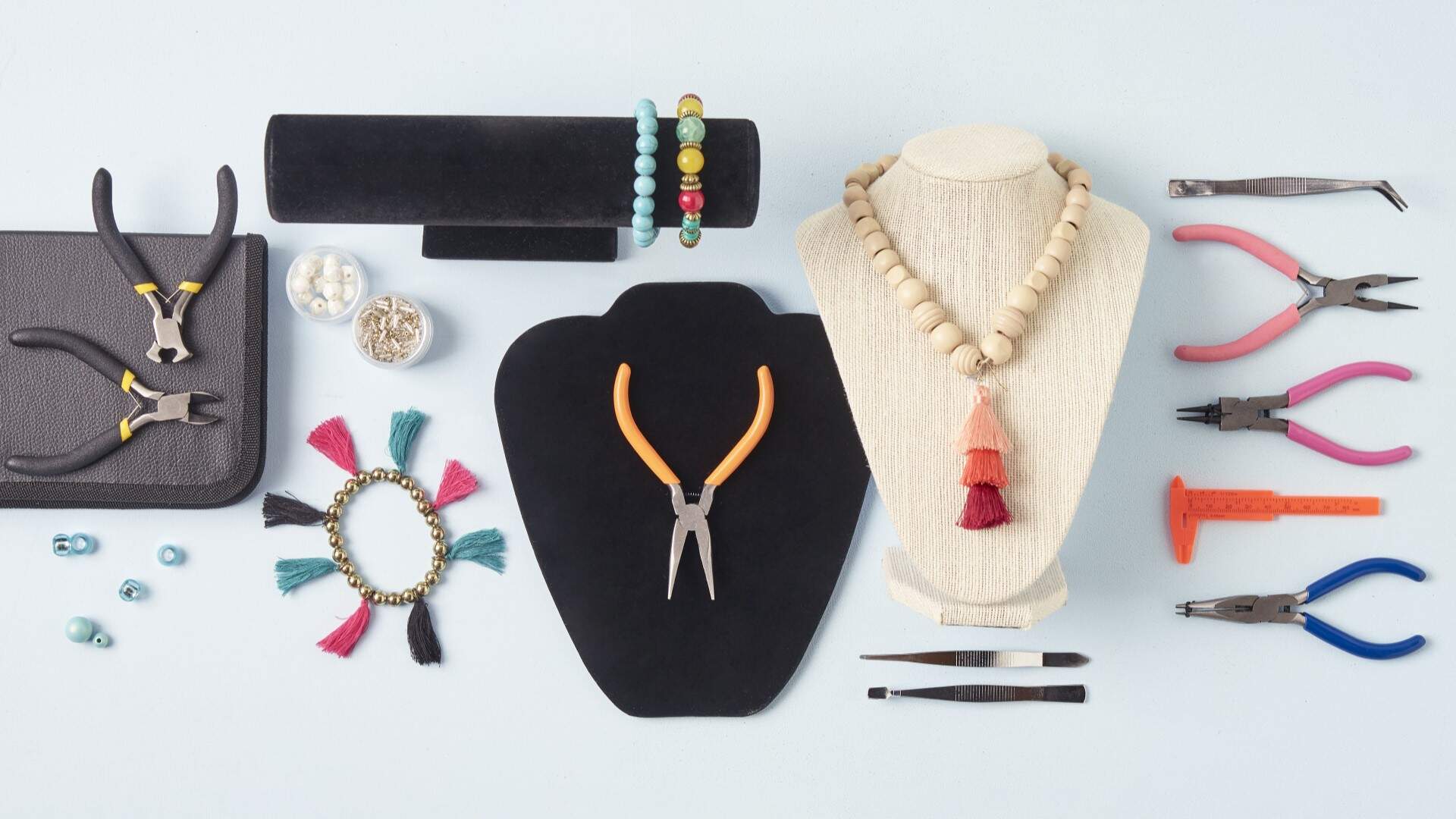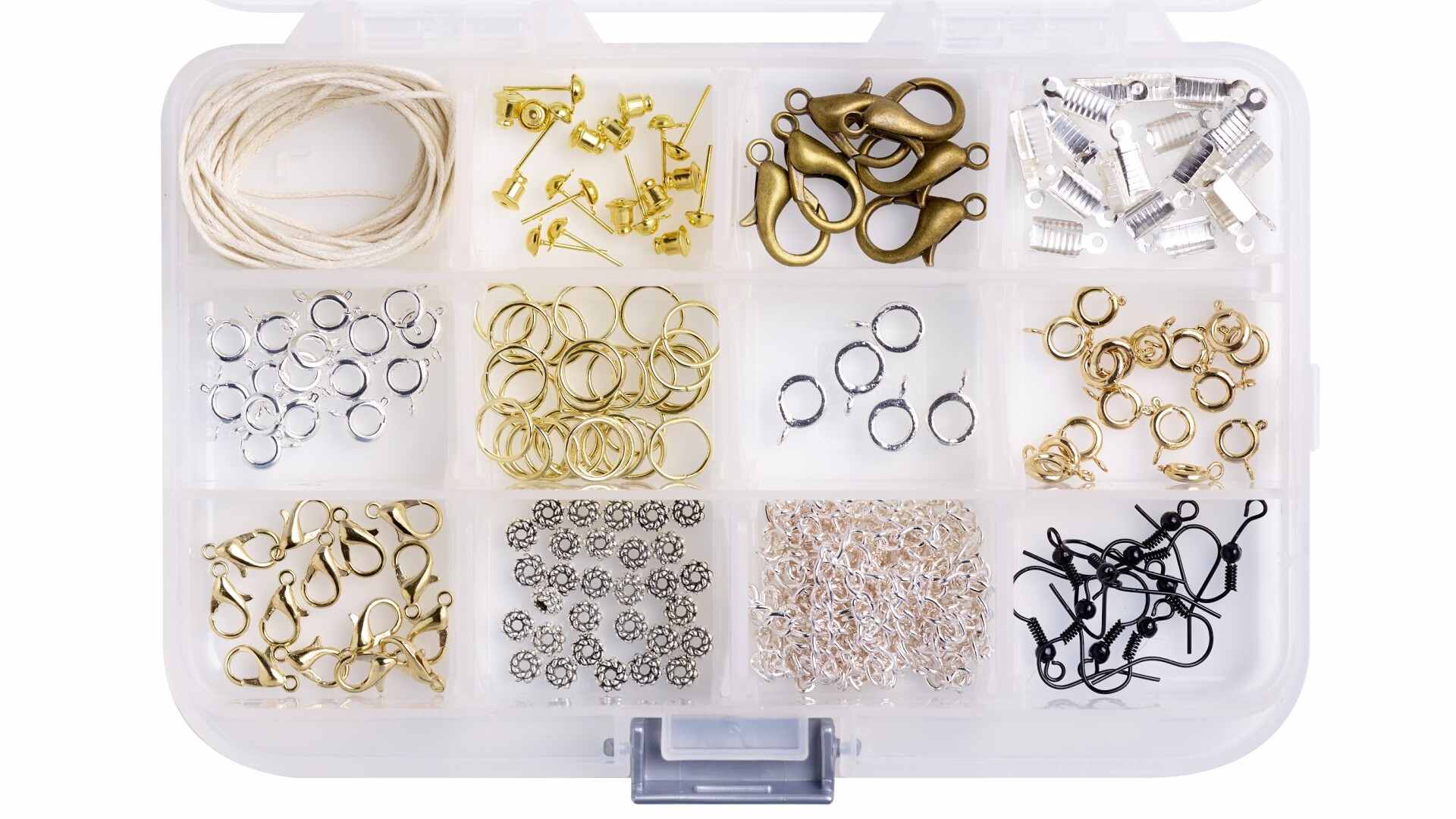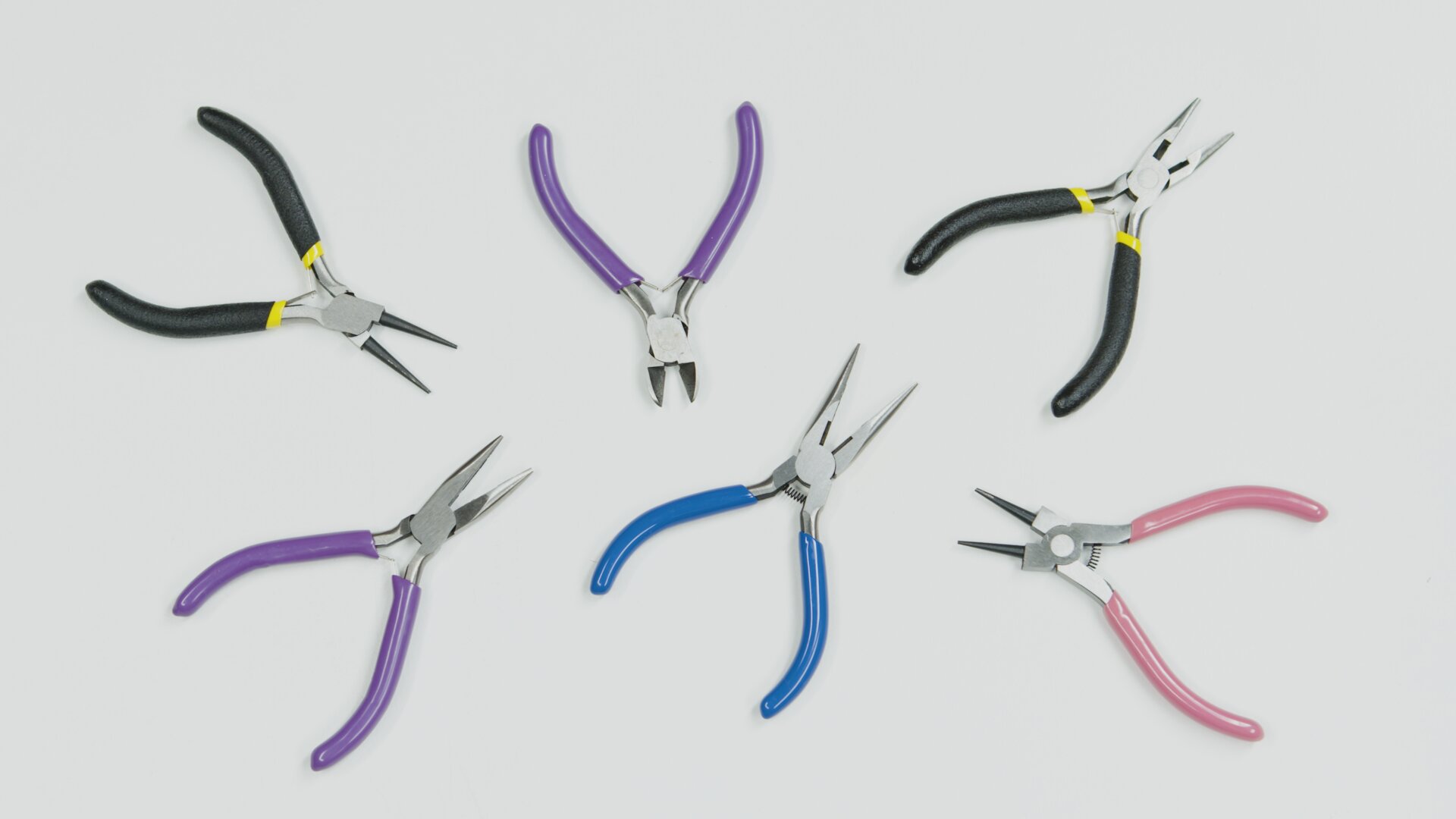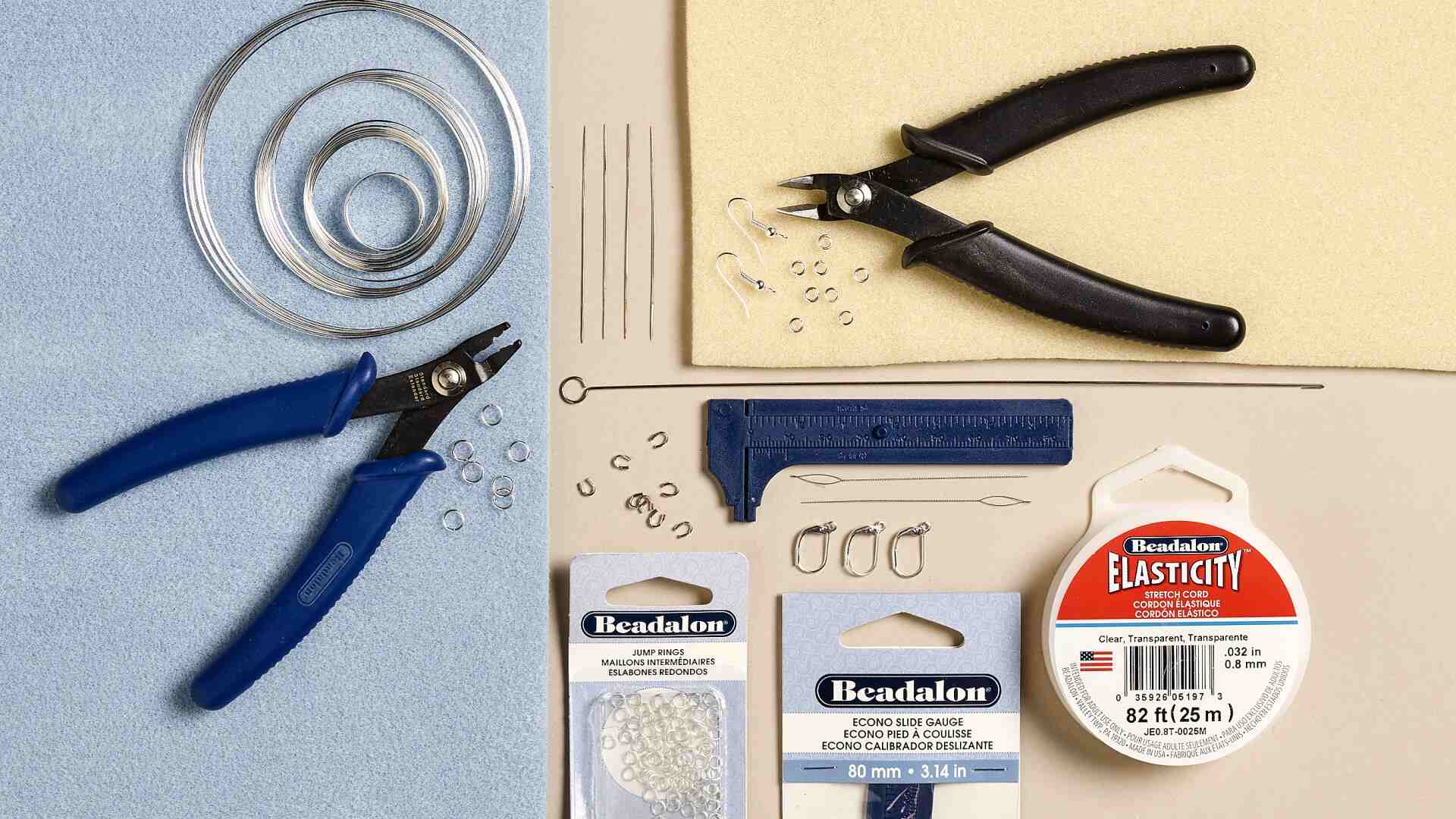 | ||
| Your browser is not supported. | ||
|
Please browse our site using any of the following options:
| ||
Your Ultimate Guide To Jewellery Findings, Tools & Stringing Materials

Creating handmade jewellery is a rewarding craft where you can make and customise pieces to suit your own unique style. If you're new to the craft or want to expand your knowledge, our handy guide is a great reference to the different types of jewellery tools and how to use them. Discover the variety of jewellery findings you can use to assemble and finish your creations, as well as the most suitable jewellery wire and stringing materials for different accessory types. Let's get making and creating!
Quick Links
- Reference Guide To Jewellery Findings
- Types Of Jewellery Pliers & Tools
- Jewellery Wire & Stringing Materials
- Learn How To Use Jewellery Tools & Findings
Reference Guide To Jewellery Findings
Findings are all the functioning components used for holding, spacing, joining, assembling and finishing jewellery pieces. They create the structure for beaded creations, and can also be decorative in their own right. Jewellery findings include items that secure accessories to your body, including clasps, earring hooks, studs, brooch backs and pins as well as hair accessory findings like clips, combs and headbands. Other types of findings include components used to assemble jewellery such as wire head pins, crimps, end bars, bead caps and jump rings.
Types Of Jewellery Clasps
Clasps are used to secure finish the ends of jewellery pieces such as necklaces and bracelets, as well as facilitating secure fastening on the body. You can find jewellery clasps in a range of metallic colours, different sizes and with different functional mechanisms.
- Barrel Clasp: Also known as a torpedo clasp, these barrel-shaped clasps are usually secured with a threaded screw mechanism. Some barrel clasps utilise a magnetic closure which some may find easier to fasten.
- Hook & Eye Clasp: A simple clasp that is secured by placing the hook through the eye.
- Bolt Ring Clasp: This classic clasp style is circular in shape and features a small lever on the side to open and securely fasten your jewellery. They're also known as ring clasp or a spring clasp on account of the mechanism it uses to open and close.
- Lobster Clasp: A clasp with a spring closure that is operated by a trigger on the outer side of the clasp. They're so named as they look like a lobster claw. Lobster clasps have a strong grip and are typically heavier and stronger than bolt rings.
- Toggle Clasp: Toggle clasps are composed of a ring and a bar. The bar must be wider than the ring, so that when it is pivoted and placed through, it will be caught by the ring when it draws back.
Crimps, Bead Caps & Cord Ends
- Crimps: Jewellery crimps are a versatile type of bead that is both functional and decorative. These small rounds or tubes of soft metal are used to secure loops on wire or other stringing material. Once in place, they are secured with crimping pliers. Crimps can also be used to create floating or suspended designs in your stranded jewellery. Secure sections of beads with crimps at either end, and leave a space on your bead cord or thread before repeating your beaded pattern.
- Folded Crimps: Serving the same purpose as barrel ends, folding crimps are placed over the end of the stringing material to finish it neatly, and provide for the addition of jump rings and clasps. They are secured by being folded closed with pliers.
- Cord ends: These findings are open at one end, and have a loop at the other. They are placed over the end of the stringing material to finish it neatly, and provide for the addition of jump rings and clasps. Some can be squeezed shut with pliers, while others require glue to hold them in place.
- Bead Caps: Bead caps are used to add an extra decorative accent to beads in your jewellery pieces. They typically resemble a hollow half-bead or hemisphere shape, which allows them to nest over or "cap" beads that you wish to highlight on your strand. They can also be used to conceal where multiple strands of thread or wire are joined together at the ends of necklaces or on earrings.
Earring Hooks, Studs & Backings
- Shepherd hooks: So named for their hooked style, shepherd hooks are essentials for making dangling earrings for pierced ears. Attach your beaded creations to the loop at the base of the hook to complete your earring designs.
- Stud findings: If you're more a fan of stud-style earrings then check out the different types of stud findings. Common stud finding types are flat backs onto which you can adhere beads or polymer clay creations. There are also ball studs where you can connect beads or chains to the earring with a small loop attached to the bottom of the stud.
- Earring hoops: These loops of fine wire are a great starting point for flamboyant designs. Thread beads onto the loop directly, or add lengths of threaded beads to the hoop using head pins or eye pins.
- Butterfly backs: These earring essentials are the name given to the fastenings that secure your studs into place. You can also find "comfort" stud backings to secure heavier stud designs.
Top Tip: If you experience allergic reactions to nickel or other alloyed metal earrings, choose sterling silver findings which are typically hypoallergenic for most earring wearers.
Head Pins & Eye Pins
- Eye pins: Lengths of wire with a loop at the end. Beads can be threaded onto the wire, and then secured by making another loop at the other end. These can be used to make dangling and connecting elements.
- Head pins: Lengths of wire with a 'head' on at the end to prevent beads falling off when they are threaded onto the wire. Once threaded, beads are secured by making a loop at the other end. These can be used to make dangling and connecting elements.
Jump Rings & Split Rings
- Jump rings: Circular pieces of wire used for joining and connecting in beadwork and handmade jewellery items. Jump rings have a break in their circumference where they can be bent open, have components attached, and then bent closed again to secure those components. You can find jump rings in a range of different diameters and wire gauges to best suit your creations.
- Split rings: Split rings are used in much the same way as jump rings, but you don't need to open and close them with pliers. Instead, use them to join looped components in much the same way you would thread keys onto a key ring.
Bails, End Bars & Other Findings
- End bars: Bars used to attach a multi-strand beaded piece to a single clasp or jump ring. They are bar-shaped, with one loop on one side and multiple loops down the other. The number of loops varies depending on the size of the project.
- Bail: Bails create loops on a pendant or other hanging item so that it can be threaded onto a necklace or chain.

Types Of Jewellery Pliers & Tools
The beader's and jeweller's tool kit is not as complicated as it might appear. With a few staple items you can be all set to make almost anything. Pliers and cutters allow you to trim and manipulate wire findings, open and close jump rings and create a range of differently-sized loops. You can also find additional specialised tools and accessories to help you organise materials and create beaded jewellery.
Jewellery Pliers & Cutters
Pliers will be some of the most used items in your kit, with different shapes used to cut and shape wire, head pins, crimps and more. It's handy to have two pairs of flat-nose pliers, so that you have one for holding an item and another for manipulating it.
- Flush Cutters: Also known as wire cutters, this tool is used for cutting most of the materials you will use in beading. They are called flush cutters because one side of the cutting edge is flat, and the other is bevelled. This creates a flat cut that is perpendicular to the end of the wire, ensuring there are no pointy, angled ends that scratch while making and wearing beaded crafts.
- Flat Nose Pliers: Flat nose pliers are very versatile, and can be used for:
- Bending and manipulating wire, head pins and eye pins.
- Gripping objects while you work with them.
- Opening and closing jump rings.
- Chain Nose Pliers: Chain nose pliers serve much the same purpose as flat nose pliers, but their tapered ends make them better at getting into smaller, tighter places, so they are particularly useful for small and intricate work.
- Crimping Pliers: Also known as crimping tools, these are used to apply crimping beads to wire. The beads are flattened and then bent by the pliers to hold joins and ends in place. Crimping pliers come in three sizes: micro, standard, and maxi. Beginners should find a standard pair a good place to start.
- Round Nose Pliers: Round nose pliers have two conical ends. These are used for bending, coiling and looping wire. The ends are tapered so that it is easy to make loops in a range of sizes.
Other Beading & Jewellery Tools
Aside from pliers and cutting tools, there are a few more handy additions that any jeweller's toolkit needs:
- Beading Needles: These superfine needles have an eye at the top that's the same diameter as the length of the beading needle. This means that beads of any shape or size can easily pass over the eye and onto your chosen stranding material. Beading needles are typically used to sew tiny beads like seed beads onto fabric, or for freehand bead weaving or bead weaving with a loom.
- Jewellery Stands & Display Materials: If you're looking to sell your jewellery creations, then the right stand and display materials are essential. They're also a super handy way to check the length and proportions of your pieces as you make them.
- Beading Mats: If you use a lot of beads in your jewellery making, then make sure you invest in a bead mat. These non-slip surfaces stop your beads from rolling around, and allow you to experiment with different patterns and combinations before threading onto a cord or wire.

Jewellery Wire & Stringing Materials
As a jeweller you can explore a huge range of materials to thread findings, charms and beads onto. From leather thonging, cord, bead thread, chain and wire, each type of stinging material will add a different functional and aesthetic benefit to your creations. Choosing an appropriate stringing material will ensure that your creation looks just right, and lasts as long as possible.
The interactions between beads and stringing materials will be different with every combination, so there are no hard and fast rules on exactly what to use each time. However, when making your choice, consider the material's size, strength, and flexibility, and how it will influence your design. For example:
- It's important to choose a wire size that will fit through your beads.
- When creating an item that is going to be worn often, choose a strong material that will not break easily.
- If you want to create a piece with movement, choose a flexible stringing material.
Beading Wire & Shaping Wire
When it comes to jewellery wire there are a couple of variations available. Cabled beading wire is a strong material widely used in all forms of beading. Made from multiple strands of stainless steel wire, cabled beading wire is wrapped in a nylon coating which protects the wearer, facilitates easy stranding of beads as well as protecting it from fraying. The strength and flexibility of a particular beading wire is determined by how many strands it is composed of. The larger the number of strands, the more flexible it will be. This wire cannot be knotted so it is best secured with crimping beads.
You can also create jewellery using shaping wire. Unlike cabled beading wire, shaping wire is simply a single strand of malleable metal wire. These wires can be made from many metals including silver, gold, copper, and stainless steel. Most commonly, shaping wire for craft jewellery is made from nickel or aluminium alloys, and may be plated to add gold or rose gold colours to the wire's surface.
Shaping wire can be used for threading, wrapping, shaping, and even crochet. It can sometimes be found with different degrees of hardness, including dead soft, half hard, and full hard. As a rule, strength and hardness increase as pliability or malleability decreases.
Shaping wire is best cut with flush cutters and manipulated with flat nose, round nose, and chain nose pliers.
Bead Thread, Cord & Chains
If you're looking to explore the art of bead weaving or prefer to create stranded jewellery that has lots of movement, then opt for bead thread to create your jewellery pieces. Bead weaving threads are super fine and strong, and made from durable synthetic filaments. Perfect for lending strength and movement to delicate woven creations, bead weaving thread can also be used to stitch beads onto fabric or to create dramatic necklace designs with multiple strands of beads. Another popular option is elastic bead thread which is ideal for creating bracelets or necklaces that don't require any additional findings for fastening.
You can also explore jewellery chains as a great starting point for creating a range of accessories. Try dangling lengths of chain from earring hooks to create swishy ear bling! You can also add beads to jewellery chains using head pins to create flamboyant necklace designs.
Shop Bead Thread, Cord & Stringing

Learn How To Use Jewellery Tools & Findings
Now that you know a little more about the different types of jewellery tools, stringing materials and jewellery findings available, there are a few key tips and tricks to making them work for you! Read on to discover some essential jewellery DIY techniques to get you started on your jewellery-making journey. You can also explore Spotlight's FREE jewellery & beading projects online for more inspiration. Our online projects feature easy-to-follow instructions, materials lists and downloadable projects sheets for your convenience.
Explore Jewellery & Beading Projects
How To Use Jump Rings
Jump rings are one of the most versatile types of jewellery findings, allowing you to join chains, head pins and charms. They're a great way to create dangling components and add a decorative element to your pieces in their own right. There is, however, a correct technique for opening and closing jump rings so that they maintain their shape and integrity.
- To open jump rings: Take two pairs of flat-nose pliers, one in each hand. Hold the jump ring in one pair of pliers, with the opening facing upwards. With the other pair of pliers in your dominant hand, clasp the jump ring on the other side of the opening. Ease the jump ring open by pulling one side toward you, and the other away. The jump ring should ease open while still maintaining its round shape.
- Closing jump rings: After adding your beads, eye pins, chain or other components to the jump ring, close it by once more using two pairs of flat nose pliers. Push each side of the jump ring opening together so it meets in the centre.
How To Shape Head Pins & Eye Pins
Creating neat loops to secure beads onto eye pins or head pins does take some practice! Over time you'll learn how much length you need to leave on the wire to create your desired loop size, and finesse the art of creating neat circular loops. For making very small loops you can use a pair of chain nose pliers. For larger loop styles a pair of round nose or half round pliers. If you need to shorten the eye or head pin wire before enclosing your beads with a loop, use a pair of flush cutters. You should have between 5 mm to 10 mm of length remaining to create your finishing loop. Here's a quick guide to creating wire loops on your head and eye pins:
- Take your pliers and bend the wire above the beads at a 90-degree angle. This step is best done with flat-nose pliers.
- Using the profile of round, chain nose or half-round pliers, slowly start bending the wire into a circular shape. Do this in small sections to gradually increase the degree of curvature.
- Once the loop is nearly formed, grip it near the tip of the wire and curve it to line up with your initial 90-degree bend.
Explore The Art Of Jewellery Making With Essential Tools & Materials From Spotlight
Now that you know a little more about the types of jewellery tools and findings that are available, you're ready to start playing, creating and exploring! Discover more about beads with our informative beads buying & DIY guide and get inspired to create stunning beaded jewellery with Spotlight. Discover the complete range of beads & jewellery at Spotlight where you can find all the essential beads, jewellery findings, stringing materials and beading tools needed to create beautiful accessories and unique jewellery designs. Head into your nearest Spotlight store to shop the range in person, or make your purchases online to enjoy the convenience of home delivery for your order.




